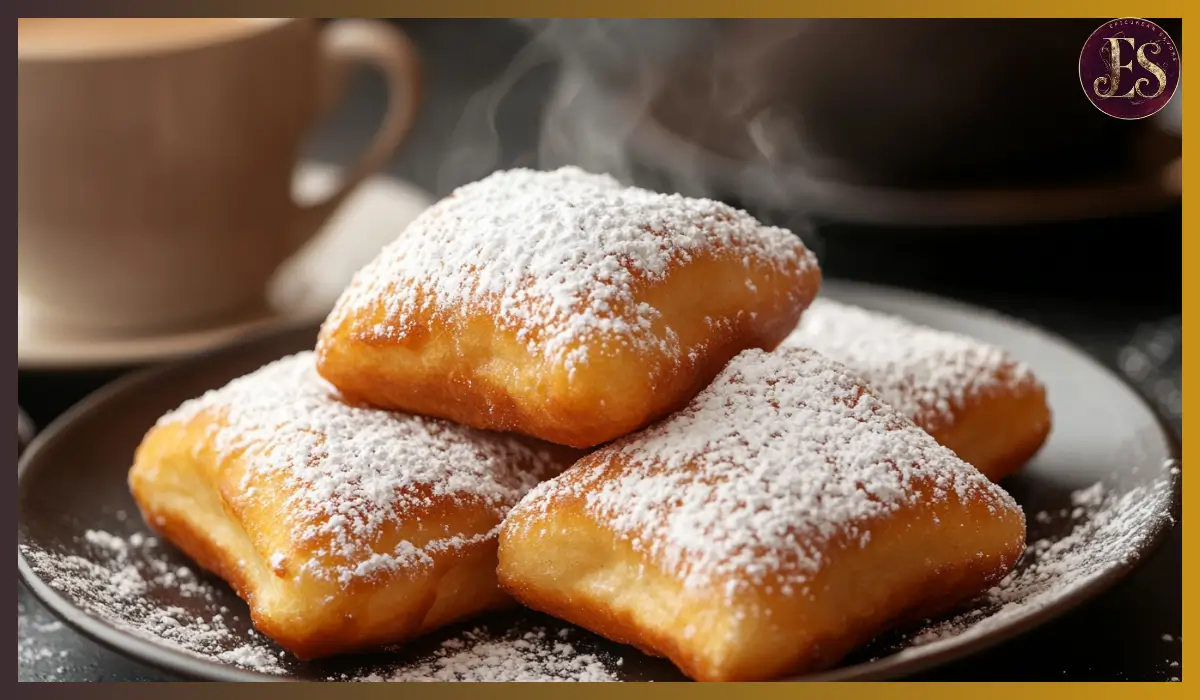There’s something undeniably magical about biting into a warm, freshly fried beignet. The crisp exterior, the airy, pillowy interior, and the generous dusting of powdered sugar all come together to create the perfect balance of textures and flavors. Now, add a touch of vanilla, and suddenly, your classic Vanilla French beignets becomes even more irresistible.
Originating from France, beignets have become an iconic treat worldwide, especially in New Orleans, where they are a staple at Café du Monde. Traditionally, they are enjoyed with a hot cup of café au lait, making them an indulgent yet comforting breakfast or dessert. While beignets may seem like a bakery-exclusive delicacy, they are surprisingly easy to make at home. With just a handful of ingredients and a few simple techniques, you can create a batch of these golden delights right in your kitchen.
The secret to the perfect beignet lies in the dough. A well-risen yeast dough gives the pastry its signature lightness, while a hint of vanilla adds warmth and depth. Fried to golden perfection and dusted with powdered sugar, these Vanilla French beignets will melt in your mouth with every bite.
If you’ve never made homemade beignets before, don’t worry. This step-by-step guide will walk you through the entire process, from mixing the dough to frying them to perfection. Whether you’re making them for a special brunch, a cozy afternoon snack, or a festive gathering, these vanilla French beignets are guaranteed to impress.
Why You’ll Love This Recipe
There are countless reasons why homemade vanilla French beignets should be on your must-try list. Not only are they absolutely delicious, but they also offer a unique sensory experience that makes them truly special.
1. Light, Fluffy, and Irresistible
The hallmark of a great beignet is its airy, cloud-like texture. Thanks to the yeast-based dough, these Vanilla French beignets puff up beautifully when fried, creating a soft and tender interior encased in a delicate golden crust.
2. Simple Ingredients, Incredible Flavor
One of the best things about this recipe is that it uses everyday pantry staples—flour, yeast, sugar, milk, butter, eggs, and vanilla. The vanilla takes these beignets to another level, adding a rich, aromatic note that enhances their overall taste.
3. Perfect for Any Occasion
Whether you’re serving them as a breakfast treat, a brunch highlight, or a dessert, beignets are always a hit. They pair wonderfully with coffee, tea, or even hot chocolate, making them a cozy and comforting indulgence.
4. Make-Ahead Friendly
The dough can be prepared in advance, making it easy to whip up a fresh batch whenever the craving strikes. You can even freeze the dough for later use, ensuring you always have homemade beignets on hand.
5. Customizable to Your Taste
This recipe can be adapted to suit your preferences. Want a touch of spice? Add a pinch of cinnamon. Love citrusy notes? Mix in some lemon or orange zest. Prefer a chocolatey twist? Dust them with cocoa powder instead of powdered sugar.
Health Benefits of Homemade Vanilla French beignets
While beignets are undoubtedly a treat, making them at home gives you control over the ingredients, making them a healthier alternative to store-bought or café versions.
1. No Artificial Additives or Preservatives
Unlike many commercial pastries, homemade beignets contain no preservatives, artificial flavorings, or unnecessary chemicals. You get to enjoy a fresh, all-natural treat.
2. Healthier Frying Options
By using high-quality vegetable or avocado oil and maintaining the right frying temperature, you can reduce excess oil absorption, resulting in lighter beignets. You can also opt for air-frying or baking for a lower-fat alternative.
3. Customizable Sugar Content
Most store-bought beignets are heavily dusted with sugar, but when making them at home, you can control how much you use. You can also experiment with healthier sugar substitutes, such as coconut sugar or maple powder.
4. Better Quality Ingredients
Using organic flour, free-range eggs, and pure vanilla extract enhances both the flavor and nutritional value of your beignets.
Preparation Time, Servings, and Nutritional Information
- Prep Time: 20 minutes
- Rising Time: 2 hours
- Cooking Time: 10 minutes
- Total Time: Approximately 2 hours 30 minutes
- Servings: 12 beignets
Nutritional Information (Per Beignet)
- Calories: 220 kcal
- Carbohydrates: 32g
- Protein: 4g
- Fat: 9g
- Saturated Fat: 3g
- Sugar: 7g
- Fiber: 1g
Ingredients List
The Dough:
- 3 ½ cups all-purpose flour
- 2 ¼ teaspoons (1 packet) active dry yeast
- ¼ cup granulated sugar
- ½ teaspoon salt
- ¾ cup warm milk (about 110°F)
- 2 tablespoons unsalted butter, melted
- 1 large egg
- 2 teaspoons pure vanilla extract
Frying:
- 3 cups vegetable oil (for deep frying)
Topping:
- 1 cup powdered sugar (for dusting)
Step-By-Step Cooking Instructions
Activate the Yeast
In a small bowl, combine the warm milk, sugar, and yeast. Let it sit for about 5–10 minutes until the mixture becomes frothy. This indicates that the yeast is active and ready to use.
Mix the Dough
In a large mixing bowl, whisk together the flour and salt. Make a well in the center and add the activated yeast mixture, melted butter, egg, and vanilla extract. Mix until a dough begins to form.
Knead the Dough
Transfer the dough to a lightly floured surface and knead for about 8–10 minutes until it becomes smooth and elastic. If the dough feels too sticky, add a little more flour, but avoid over-flouring, as this can make the beignets dense.
First Rise
Place the dough in a greased bowl, cover it with a clean kitchen towel, and let it rise in a warm, draft-free area for about 1.5 to 2 hours, or until it doubles in size.
Roll and Cut
Once the dough has risen, punch it down to release excess air. Roll it out on a floured surface to about ¼-inch thickness. Using a sharp knife or a pastry cutter, cut the dough into 2-inch squares.
Heat the Oil
In a deep, heavy-bottomed pot, heat the vegetable oil to 360°F (182°C). Use a thermometer to ensure accurate temperature control.
Fry the Beignets
Carefully drop a few beignets into the hot oil, making sure not to overcrowd the pot. Fry for about 1–2 minutes per side until golden brown. Use a slotted spoon to remove them and drain on a paper towel-lined plate.
Dust with Powdered Sugar
While the beignets are still warm, generously dust them with powdered sugar.
How to Serve
- Serve immediately for the best texture and flavor.
- Enjoy them with a cup of hot coffee, tea, or milk.
- Pair with a side of chocolate or caramel dipping sauce for extra indulgence.
- Sprinkle a bit of cinnamon or nutmeg for added warmth.
Pairing Suggestions
- Drinks: Café au lait, hot chocolate, or chai tea.
- Fruits: Fresh berries or citrus slices.
- Dips: Nutella, caramel sauce, or berry compote.
Storage, Freezing & Reheating Instructions
- Store leftover beignets in an airtight container at room temperature for up to 2 days.
- To freeze, place in a single layer on a baking sheet before transferring to a freezer bag. Freeze for up to 3 months.
- Reheat in a 350°F oven for 5 minutes or an air fryer at 300°F for 2–3 minutes.
Alternative Cooking Methods for Beignets
While traditional beignets are deep-fried to achieve that perfect crispy exterior and fluffy interior, there are other methods to prepare them with different textures and health benefits. One alternative is baking—instead of frying, arrange the cut beignet dough on a parchment-lined baking sheet and bake at 375°F (190°C) for about 12–15 minutes or until golden brown. Though they won’t have the same airy crispness, they will still be light and delicious.
Another option is air frying, which reduces oil usage while still providing a crispy texture. Preheat your air fryer to 350°F (175°C), lightly spray the basket with oil, and cook the beignets in batches for 5–6 minutes, flipping halfway through.
For a more rustic version, you can also pan-fry the beignets in a small amount of oil. This method requires frequent flipping to ensure even cooking but can be a good compromise between frying and baking.
How to Make Your Beignets Extra Flavorful
Beignets are naturally delicious with their delicate sweetness and fluffy texture, but there are plenty of ways to enhance their flavor. For a warm, spiced touch, add a pinch of cinnamon or nutmeg to the dough. This will give your beignets a subtle depth that pairs beautifully with coffee or tea.
If you love citrus flavors, try adding a teaspoon of orange or lemon zest to the dough. This small addition brightens up the beignets and gives them a refreshing twist.
For a rich, gourmet experience, consider filling your beignets with flavored creams or custards. After frying, inject them with vanilla pastry cream, chocolate ganache, or fruit preserves using a piping bag.
For a slightly caramelized effect, drizzle them with honey, maple syrup, or a light dusting of cinnamon sugar instead of powdered sugar.
How to Troubleshoot Common Beignet Problems
Making homemade beignets is a rewarding process, but a few common mistakes can affect the final result. If your beignets are too dense, it’s likely that the dough was over-kneaded or didn’t rise long enough. Make sure to let the yeast activate properly and allow the dough to rise in a warm, draft-free environment.
If the beignets are greasy, the frying oil was probably too cool. Maintain a steady temperature of 360°F (182°C) and avoid overcrowding the pan, which lowers the temperature.
Beignets that turn out too dark on the outside but raw inside were fried in oil that was too hot. Reduce the heat slightly and fry in smaller batches.
If they lack flavor, double-check that you’ve added enough sugar, vanilla, and salt to the dough. The quality of vanilla extract also makes a significant difference in taste.
How to Turn Beignets into a Show-Stopping Dessert
While classic beignets dusted with powdered sugar are already a delight, they can be transformed into a more elaborate dessert. One idea is to serve them with a dipping trio—small bowls of melted chocolate, caramel sauce, and fruit coulis allow guests to customize each bite.
For a French-inspired touch, drizzle warm beignets with homemade crème anglaise, a rich vanilla custard sauce that pairs beautifully with the light pastry.
Beignets can also be stacked into a tower and drizzled with honey or chocolate sauce, then sprinkled with chopped nuts or shredded coconut for texture.
If you love ice cream, try making a beignet sundae by placing a scoop of vanilla or caramel ice cream between two warm beignets and topping with whipped cream and sauce.
For a New Orleans-style twist, coat the beignets in a mix of powdered sugar and cinnamon, then serve alongside chicory coffee or café au lait.
Frequently Asked Questions (FAQs)
1. Can I make beignets ahead of time?
Yes! You can prepare the dough in advance and refrigerate it overnight. Let it come to room temperature before rolling and frying.
2. Can I freeze beignet dough?
Absolutely. After the first rise, shape the dough into squares and freeze them on a baking sheet. Once frozen, transfer them to a freezer-safe bag. Thaw before frying.
3. How do I reheat beignets?
For best results, reheat them in a 350°F (175°C) oven for 5 minutes or in an air fryer at 300°F (150°C) for 2–3 minutes. Avoid microwaving, as it can make them soggy.
4. Why are my beignets oily?
Oily beignets usually mean the frying oil was too cold. Keep it at 360°F (182°C) and fry in small batches to maintain the temperature.
5. Can I use instant yeast instead of active dry yeast?
Yes! If using instant yeast, you can mix it directly into the flour without proofing. The rise time may be slightly shorter.
6. What oil is best for frying beignets?
Neutral oils like vegetable oil, canola oil, or peanut oil work best because they have a high smoke point and don’t overpower the flavor.
7. Can I use a different flour?
All-purpose flour is best for traditional beignets, but you can use bread flour for a chewier texture or a gluten-free blend with xanthan gum for a gluten-free version.
8. How do I prevent beignets from sticking together while frying?
Fry them in small batches and avoid overcrowding the pot. Use a slotted spoon to separate any beignets that stick together.
9. Can I make these beignets dairy-free?
Yes! Use almond, oat, or coconut milk instead of regular milk, and replace butter with dairy-free margarine or coconut oil.
10. How do I make beignets extra fluffy?
Ensure the dough has risen properly, avoid over-kneading, and let them proof for 10 minutes before frying. Also, check that your yeast is fresh.
Conclusion & Call to Action
Making vanilla French beignets at home is easier than you think. With a little patience and the right technique, you can enjoy a fresh, homemade version of this beloved pastry anytime. Try this recipe and share your experience!
Print
Vanilla French Beignets
- Total Time: 2 hours 30 minutes (including rising time)
- Yield: 12 beignets 1x
- Diet: Vegetarian
Description
Light, airy, and delicately sweet, these homemade vanilla French beignets are fried to golden perfection and dusted with powdered sugar. Perfect for breakfast, dessert, or a sweet snack, they pair beautifully with coffee or hot chocolate.
Ingredients
- 3 ½ cups all-purpose flour
- 2 ¼ teaspoons (1 packet) active dry yeast
- ¼ cup granulated sugar
- ½ teaspoon salt
- ¾ cup warm milk (110°F)
- 2 tablespoons unsalted butter, melted
- 1 large egg
- 2 teaspoons pure vanilla extract
- 3 cups vegetable oil (for frying)
- 1 cup powdered sugar (for dusting)
Instructions
- Activate Yeast: In a small bowl, mix warm milk, sugar, and yeast. Let it sit until frothy (5–10 minutes).
- Prepare Dough: In a large bowl, whisk flour and salt. Add yeast mixture, melted butter, egg, and vanilla. Mix until a dough forms.
- Knead Dough: Knead for 8–10 minutes until smooth.
- First Rise: Cover and let the dough rise in a warm place for 1.5 to 2 hours.
- Roll & Cut: Roll dough to ¼-inch thickness and cut into 2-inch squares.
- Heat Oil: Preheat vegetable oil to 360°F (182°C).
- Fry Beignets: Fry each for 1–2 minutes per side until golden brown. Drain on paper towels.
- Dust with Sugar: While warm, coat with powdered sugar and serve immediately.
Notes
- Ensure the oil stays at 360°F for even frying.
- Beignets taste best fresh but can be stored for later.
- Use high-quality vanilla extract for the best flavor.
- Prep Time: 20 minutes
- Cook Time: 10 minutes
- Category: Dessert, Breakfast
- Method: Frying
- Cuisine: French


